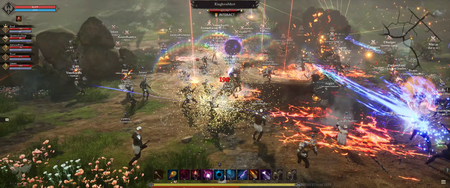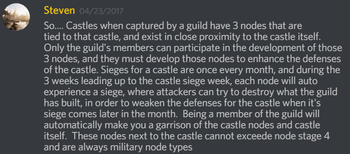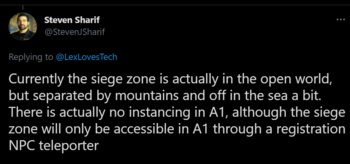Asedios a castillos

Throughout Ashes of Creation, the player has an opportunity to participate in massively multiplayer siege warfare. Since castles are likely the world’s most limited resource, it will be a task to secure and hold them. Involving hundreds of players on a single battlefield, our sieges will employ many moving parts and intricate design features. Because of the difficult nature of taking and keeping a castle there are great rewards available to the players for their efforts. Castles will allow players to exert control over nearby lands and allow for the development of unique buildings in the nearby towns.[2]
Los gremios participan en asedios a castillos en un intento por capturar y ocupar uno de los cinco castillos de gremio en Ashes of Creation.[3]
- Estos asedios se desarrollan una vez al mes dentro de un horario de máxima audiencia del servidor.[4][3][5][6]
- El objetivo mínimo es que haya 250x250 jugadores en un mismo campo de batalla. Se espera que, con el tiempo, pueda aumentarse a 500x500.[7][8][9][10]
- Habrá sistemas que imiten algunas de las mecánicas de los asedios, pero no habrá asedios de práctica.[11]
- Es posible que haya zonas instanciadas dentro de los asedios a castillos y nodos de mundo abierto, donde grupos específicos puedan participar en pequeñas batallas de corta duración basadas en objetivos que afectarán al resultado general del asedio.[12]
Un gremio que capture un castillo será dueño de ese castillo durante un mes antes de que vuelva a ser asediado.[17][18]
- Each week leading up to the siege week... is a week that's dedicated to one of the three castle dedicated nodes. So around the castle there are three nodes. They represent week, one, two, and three; and then the fourth week is the siege against the castle. Those can only be elevated up to stage three. We've discussed this in the past and there's definitely information out there on the community ran wiki.[17] – Steven Sharif
- En las tres primeras semanas que un gremio ocupe un castillo tendrá que subir de nivel cada uno de sus nodos de castillo hasta la fase de aldea mediante misiones.[17][18]
- La cuarta semana es la semana de la declaración de asedio, en la que otros gremios tienen la oportunidad de colocar su bandera de declaración o apuntarse como defensor del castillo.[17][18]
- En función de lo bien que el gremio defienda sus nodos del castillo, mejorarán las defensas del castillo.[18][19]
- Diferentes armas de asedio otorgarán a los atacantes la capacidad de destruir muros, puertas y secciones del castillo para acceder a la zona del torreón interior.[20]
- Cuando los castillos cambian de manos (trás un asedio), algunos impuestos se quedan en el castillo y otros en el gremio.[21]
- There will be benefits to attracting people... even if they're not in your guild or alliance – a feudal like system, where you can attract other players who are just independent of this whole politic. They will have things to do there - benefits to receive - and there will be a reciprocal relationship between who you can attract, what they do for you; and how that benefits you and them.[18] – Steven Sharif
Siege mechanics
A siege occurs over several phases.[22]
- Certain siege mechanics may be gated for specific size groups during sieges.[23]
- There will not be a deserter debuff for leaving a siege before it is complete.[24]
- More will be revealed in an upcoming blog entry.[22]
Pvp
Sieges don't use the PvP flagging system.[25]
Death penalties do not apply to objective-based events (such as caravans, guild wars, and node sieges).[26]
NPCs
Siege NPCs, NPC guards, and mercenary NPCs serve as defense points during sieges and other events.[27][28]
- Only combat NPCs are killable during a siege. Non-combat NPCs, such as merchants, will despawn and will respawn if the siege is unsuccessful.[27][29]
- Upgrades to the node's Barracones may allow a garrison of siege NPCs to be spawned in the event of an attack.[27]
- PNJs mercenarios can be hired in advance.[27] They are intended to be a significant presence but not the main line of defense in a siege.[30]
Siege objectives
Each node has a number of districts, depending on its stage.[22]
- Districts are taken by defeating a "raid boss" guard NPC in that district.[22]
- If attackers take over a district, they gain that district as a respawn location.[22]
- Attackers can kill the quartermasters to increase the respawn times of the defenders while reducing their own respawn times.[31][22]
Defenders can assault the outposts of the attackers to hinder them.[22]
Attackers may not be capable of deleveling a node. Instead they may carry out precision attacks to disable specific service-oriented buildings within the node. These buildings can be targeted with siege weapons and bombs.[33]
As the attackers are sieging a city they have obviously a win condition- a win objective- but additionally there can be casualties from a structural standpoint during that process. So let's say if the... attackers were to not succeed in completely destroying the node they could still affect damage across multiple types of buildings that are present within the node, which disables services for that those citizens and also will require some type of reconstruction effort on behalf of the citizens.[34] – Steven Sharif
Ver además
Referencias
- ↑ Vídeo, 2021-05-28 (25:44).
- ↑ About Ashes of Creation.
- ↑ 3.0 3.1

- ↑ Transmisión en vivo, 2022-07-29 (1:12:14).
- ↑ Entrevista, 2020-07-29 (31:05).
- ↑ Entrevista, 2020-07-18 (13:13).
- ↑ Transmisión en vivo, 2021-09-24 (52:48).
- ↑ Entrevista, 2021-07-08 (57:19).
- ↑ Entrevista, 2020-07-19 (44:28).
- ↑

- ↑ Twitch Bustin - Practice Sieges?
- ↑ Transmisión en vivo, 2022-01-28 (17:50).
- ↑ 13.0 13.1 Pódcast, 2021-04-11 (49:40).
- ↑

- ↑ Transmisión en vivo, 2021-04-30 (41:18).
- ↑ Blog: Creative Director's Letter, April 14 2021
- ↑ 17.0 17.1 17.2 17.3 Transmisión en vivo, 2020-08-28 (1:43:03).
- ↑ 18.0 18.1 18.2 18.3 18.4 18.5 Pódcast, 2018-04-23 (21:55).
- ↑ 19.0 19.1 Transmisión en vivo, 2017-08-23 (23:00).
- ↑ Pódcast, 2018-04-23 (15:14).
- ↑

- ↑ 22.0 22.1 22.2 22.3 22.4 22.5 22.6

- ↑

- ↑ Transmisión en vivo, 2017-05-24 (37:05).
- ↑ Transmisión en vivo, 2017-05-19 (45:14).
- ↑ Transmisión en vivo, 2020-12-22 (1:13:51).
- ↑ 27.0 27.1 27.2 27.3 Transmisión en vivo, 2023-08-31 (2:09:32).
- ↑

- ↑

- ↑ Transmisión en vivo, 2017-07-28 (36:51).
- ↑ 31.0 31.1 Entrevista, 2020-07-19 (37:58).
- ↑ Transmisión en vivo, 2017-05-19 (47:07).
- ↑ Transmisión en vivo, 2019-11-22 (17:59).
- ↑ Transmisión en vivo, 2019-11-22 (15:48).